Harvesting radishes for the winter: simple and delicious recipes for healthy snacks
Radish is prized as an early vegetable. Get your first greenhouse crop radish can be done in April. To preserve the vegetable as long as possible, the root vegetables are pickled, salted, canned and frozen.
Today, a large number of ways of harvesting radish for the winter are known. In the article, we will discuss how to choose and prepare radishes, as well as consider recipes for how to salt in a jar, pickle, as well as other methods of harvesting.
The content of the article
What radish is suitable for harvesting for the winter
For preservation, usually use large fruits with a diameter of 2.5 cm, covered with a thin skin. The color of the roots can be different: pink, white, red, purple. They also differ in shape: from flat-rounded to fusiform. The standard variant is Anabel F1, Zlata, Champion, Politez, Molniya F1.
To preserve a vegetable for the winter, it is better to choose varieties with a medium or late ripening period. They are tastier and last longer. These include the Red Giant, Zlata, Cherriet variety. The choice of variety also depends on the characteristics of the recipe.
If it is necessary to harvest whole root crops, varieties with an even, regular shape should be chosen. If you want to grind a vegetable, preference is given to large-sized fruits with juicy pulp.
Council. When buying a radish, pay attention to the appearance: the roots must be intact, without traces of spoilage, dense to the touch.
The quality of the fruit is influenced by the correct harvest. It is important to remove the green leaves within five hours of digging. Otherwise, the pulp becomes watery.
Fruit preparation
Remove foliage and tails from root crops, rinse several times with running water. Remove dried dirt gently with a dishwashing sponge. If the roots are sluggish and soft to the touch, it is recommended to soak them for one hour in cold water.
How to prepare radishes for the winter in banks - the best recipes
There are many different recipes for harvesting radishes for the winter. Due to the wide variety of options, everyone will find a recipe based on taste preferences. Below we will consider a classic method of preserving radishes, and for lovers of the original, a recipe for radishes with red currants and salted radishes with tops.
Canned radish with vinegar and herbs
Ingredients for 5 servings:
- radish - 0.5 kg;
- fresh dill;
- green onion;
- black peppercorns and fragrant 3-4 pcs;
- bay leaf;
- cloves - 2 pcs.
Marinade:
- water - 50 ml;
- salt - 2 tsp;
- sugar - 4 tsp;
- table vinegar 9% - 50 ml;
- vegetable oil - 2 tablespoons
Recipe:
- Remove the tops and tails from the radish, rinse well with water.
- Cut large root vegetables into halves or quarters.
- Rinse greens, dry on a paper towel. Remove the green feathers from the onion; they will not be needed.
- Finely chop the dill and fleshy white onion leg.
- At the bottom of the sterilized jars, alternately lay out a layer of radish, a layer of green onions. Put whole sprigs of dill and parsley on top.
- Put black peppercorns, allspice, bay leaf, cloves in the jars, add vegetable oil.
- Prepare a marinade from water, sugar, salt, bring to a boil. At the end, pour in the vinegar and boil again.
- Pour radish with hot marinade. Close the jars with sterilized lids.
- At the bottom of the pan, place a special stand for sterilizing cans or cover with a towel folded in several layers. Lower the cans, fill the pan with hot water up to the level of the cans' hangers. Sterilize for 7-10 minutes.
- Turn the jars upside down, wrap them in a warm blanket, leave for 1-2 days until they cool completely.
- Store in a cool dark place, you can refrigerate.
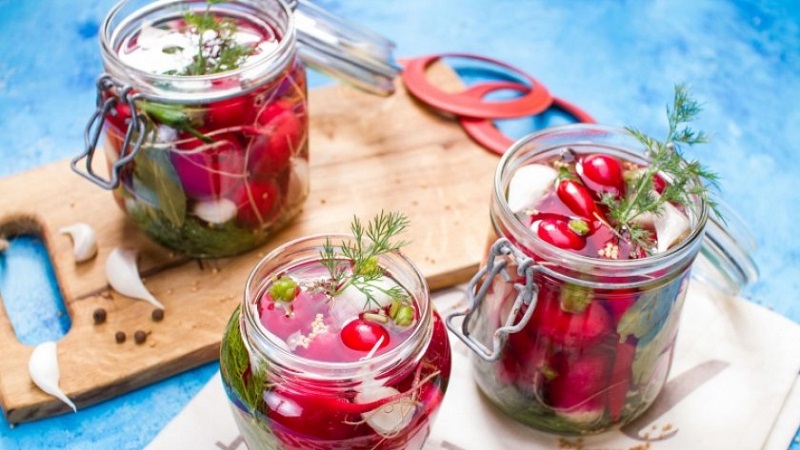
Korean radish for the winter
Ingredients:
- radish - 0.5 kg;
- green onions - 1-2 bunches;
- garlic - 3-4 cloves;
- 1 pod hot pepper;
- salt - 100-150 g.
Cooking method:
- Wash the radishes, remove the leaves and tails. Cut the root vegetables into slices or slices. If desired, you can add finely chopped tops. The leaves will add spice to the workpiece, improve the taste.
- Rinse pepper, remove seeds, chop finely.
- Chop the peeled garlic using a press or also finely chop. Mix with hot pepper.
- Pour the radish into a dry, clean container, add the garlic-pepper mixture, salt. Mix everything well, you can even use your hands - this way the roots will be evenly salted, the juice will be released faster.
- Next, add finely chopped green onions to the vegetables. Use both the green feathers and the white fleshy part. Mix everything well again.
- Place radishes tightly in sterile jars. Close full jars with sterilized metal lids.
- Banks should stand for 1-2 days at room temperature, then put in a cold room.
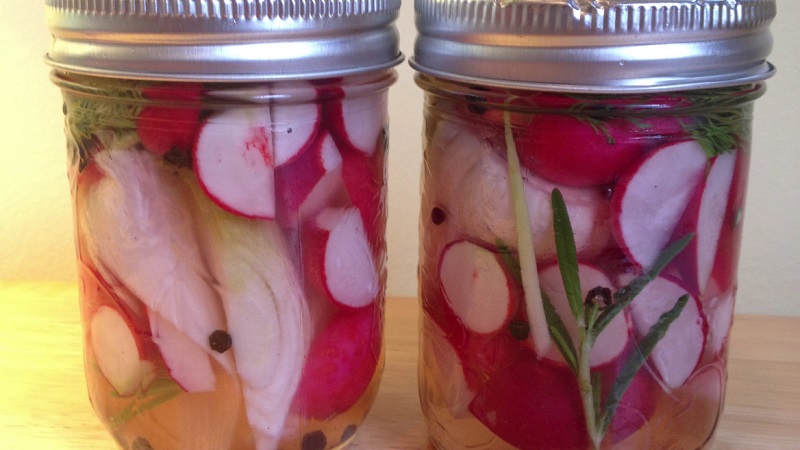
Salted radish with tops
Ingredients:
- radish - 700-1000 g;
- green onions;
- half a red hot pepper;
- garlic - 2-4 cloves;
- salt to taste.
Recipe for how to salt in a jar:
- Rinse the radishes well, remove the tails. Do not cut off the tops. Cut large root vegetables in half.
- Coarsely chop the green onion. It is best to choose a plant with large green feathers as they are more aromatic.
- Prepare a dressing with minced garlic and minced red hot pepper.
- In a separate bowl, mix the onion and radish. Cover with salt and mix well again. Season with a spicy mixture.
- Leave on for 30-60 minutes. Then spread out in clean sterile jars, cover with a plastic lid. Leave warm. After three days, put the jars in a cool place, you can put them in the refrigerator.
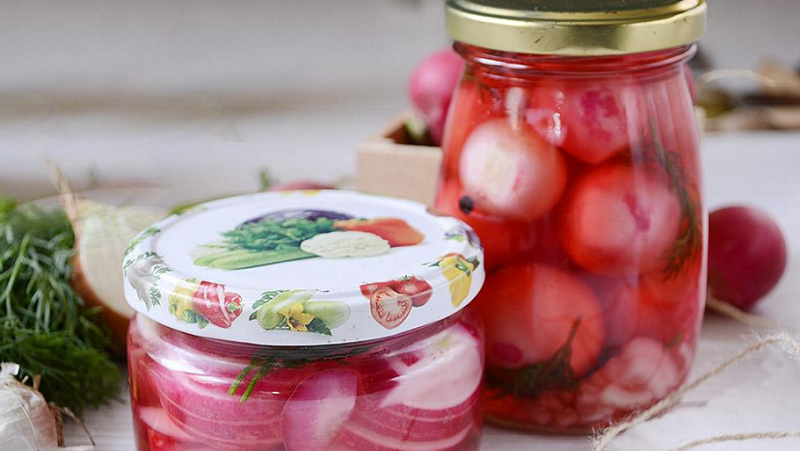
Lightly salted radish
Products:
- radish - 0.5 kg;
- sugar - 2 tablespoons;
- table vinegar 9% - 2 tablespoons;
- salt - 2 tablespoons;
- water - 50 ml.
Recipe:
- Wash root vegetables, remove tails, peel. Cut into 4 pieces.
- In a container, mix sugar, salt, vinegar, water. Pour radish with cold brine, mix everything well.
- Put vegetables in the refrigerator for a day. Then put in sterile jars, close with metal lids.
- Store in a cool, well-ventilated area.
Red currant recipe
Ingredients for two 0.5 liter cans:
- radish - 1.5 kg;
- red currant - 100 g;
- onions - 0.5 kg;
- water - 1 l;
- salt - 2 tablespoons;
- sunflower oil - 150 g;
- black pepper peas - 5 pcs.
How to cook:
- Remove tails and leaves from radish, rinse. Put chopped onions at the bottom of sterilized jars, and root vegetables on top.
- Separate the currant berries from the branches, rinse, grind through a sieve.
- Prepare marinade from water, salt and currant juice with pulp. Boil.
- Heat the sunflower oil separately, pour 75 ml into each jar.
- Next, pour hot brine over the radish.
- Prepare the pan for sterilization: put a special device for jars on the bottom or lay a towel folded in several layers. Lower the banks. Pour hot water into a saucepan up to the level of the can's hangers. Sterilize after boiling for 15 minutes.
- Close with metal lids. Turn the jars upside down, wrap them up, leave for 1-2 days until they cool completely.
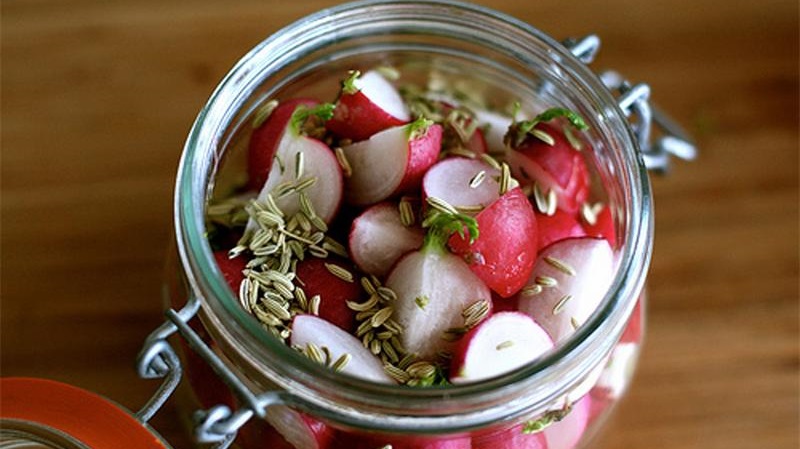
Pickled radish with aspirin
Products:
- radish - 250 g;
- salt - 1 tsp;
- sugar - ½ tsp;
- water - 250 ml;
- vinegar - 50 g;
- dill greens;
- Aspirin - 1 tablet.
Recipe:
- Rinse the root vegetables, remove the tails.
- Sterilize banks in a convenient way, decompose the radish.
- Boil water, add radish. Leave on for 15 minutes.
- Drain the water back into the pan, add salt, sugar, boil everything again. At the end, pour in the vinegar, bring to a boil again.
- Put whole sprigs of dill in jars on top, you can cut them. Pour with boiling marinade, add one aspirin tablet, close with metal sterilized lids.
- Turn the jars upside down, wrap them in a warm blanket for 1-2 days. Store blanks in a cellar or pantry.
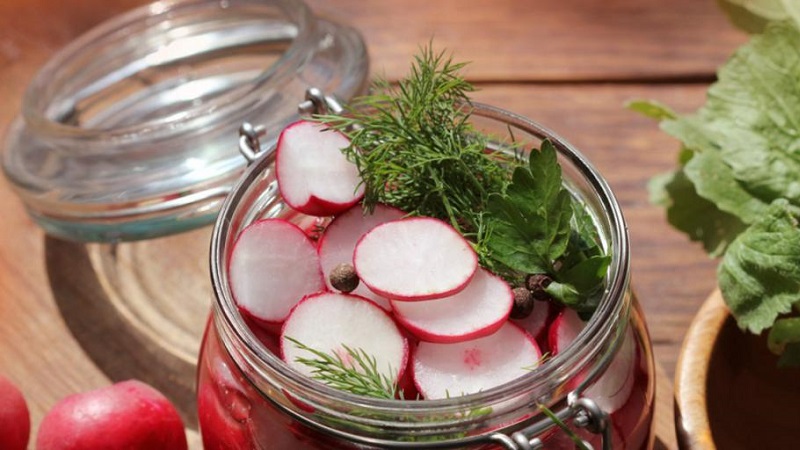
Onion and Garlic Recipe
Ingredients:
- radish - 0.5 kg;
- onions - 250 g;
- garlic - 4-5 cloves;
- bay leaf - 2 pcs.;
- black peppercorns - 5-6 pcs.;
- dill.
Brine:
- water - 500 ml;
- salt - 15 g;
- table vinegar 9% - 35 g.
Recipe:
- Wash the radish, cut off the tails, chop into 7-10 mm thick slices.
- Peel the onion and garlic, rinse, cut into slices.
- Put onion and garlic on the bottom of sterilized jars, then radish, dill sprigs on top.
- Pour the workpieces with boiling water, leave for 5-10 minutes, drain the water into a saucepan.
- Add salt, sugar, spices to the water, pour in vinegar after boiling.
- Fill jars with hot brine, close with metal sterilized lids.
- Turn over, wrap with a warm blanket. When the jars are completely cool, lower them into the cellar.
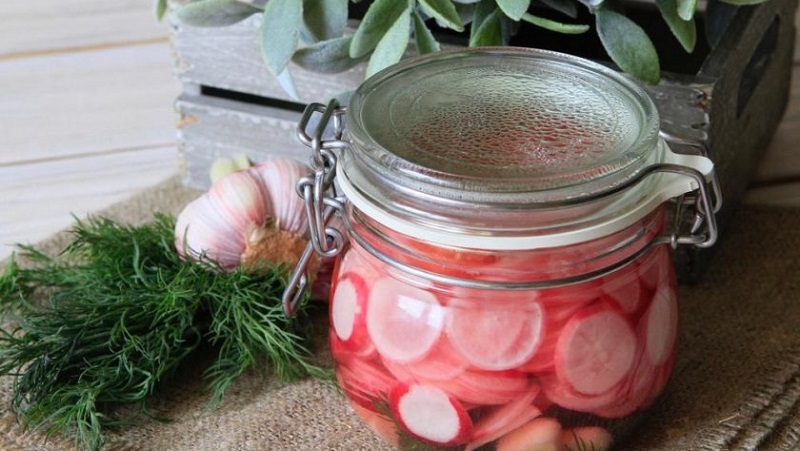
How to preserve banks correctly
To extend the shelf life of preservation and preserve the taste, it is important to follow the standard recommendations on how to properly preserve radishes for the winter:
- Choose root vegetables of the same size, fresh, free from spoilage, elastic to the touch.
- Rinse the radishes thoroughly before cooking. To remove dried dirt, soak root vegetables in cold water for half an hour.
- Prepare jars and lids. Inspect the dishes for damage. Chipped cans cannot be used. The covers should be flat, not bent.
- To check the jar for leaks, fill it with water and shake it. If the water does not pour out, then the can is closed tightly.
- Wash the jars thoroughly with baking soda or mustard powder to remove germs. Better to use a new sterile sponge.
- Sterilize jars and lids in a convenient way. The best option is an oven. A lot of cans can be placed at a time. You can put the lids on immediately.
- Put vegetables in dry jars. Can be filled up to the hanger or under the lid. The latter option is better, since the less air there is, the lower the likelihood of oxidation and fermentation.
- After capping, turn the jars upside down and see if the contents leak.
- The workpieces should cool down gradually. To do this, turn the jars upside down, wrap them in a warm blanket, and leave for 1-2 days.
Store workpieces in a dark, cool, well-ventilated area. The ideal option is a cellar. Some blanks can be stored in the refrigerator.
For reference. The shelf life of conservation is 24 months. But it is better to eat the blanks before the next harvest season.
Workpieces with and without sterilization
Sterilization of cans is carried out thermally in order to destroy germs, bacteria, spores. Thanks to this process, the workpieces are better preserved, the likelihood of oxidation, mold formation is practically reduced to zero.
How to properly sterilize cans with a blank:
- In a pan with a wide bottom, put a special device for fixing the cans during sterilization or cover with a towel (other cloth) folded in several layers.
- Gently place hot filled jars in a saucepan. You can also put matter between them. Cover with lids, but do not tighten.
- Pour hot water into a saucepan up to the hangers of the cans.
- After boiling, sterilize half-liter jars for 7-10 minutes and liter jars for 10-20 minutes.
- Next, remove the hot cans from the water and seal them.
If sterilization is not provided by the recipe, then it is imperative to fill the jars with boiling brine and immediately close them with metal lids using a seaming key or screw caps. Jars and lids must be pre-sterilized.
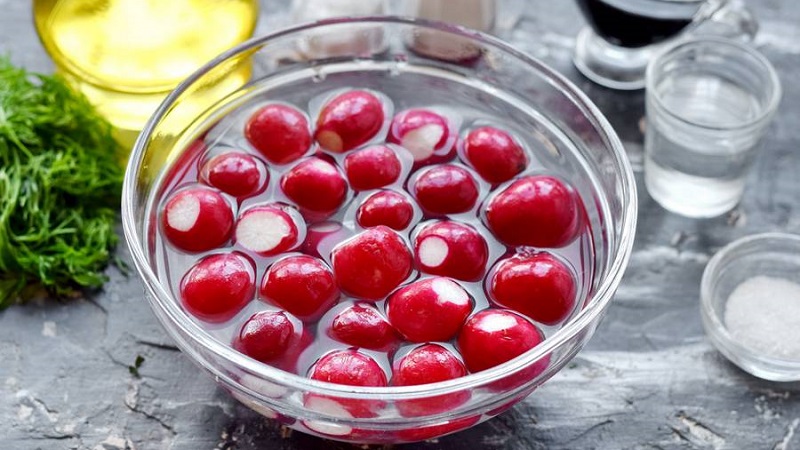
Harvesting by freezing
For freezing, you should select whole elastic roots, preferably of the same size. Cut off the tails and leaves of the radish, rinse well, remove the remaining water with a paper towel. Cut large root vegetables in half or in four parts.
Further, so that no water is released from the radish during storage, which will turn into ice, freezing should be started from low temperatures. Put the root vegetables in the freezer for 10-15 minutes at minus 30-40 degrees. Then pack it in special bags for freezing, store in the freezer at temperatures from -6 to -24 degrees. The shelf life is 12 months.
Conclusion
Now you know the most popular and easy-to-prepare recipes for preparing radishes for the winter. This vegetable is a versatile food product that is consumed fresh, canned, salted, pickled, and frozen.
Follow these simple rules of preparation and then your family members will appreciate its excellent taste.